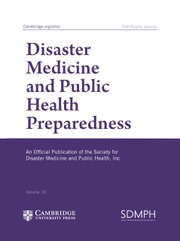Article contents
The Effect of Disaster Preparedness Literacy on Individual Disaster Resilience
Published online by Cambridge University Press: 04 November 2024
Abstract
This study aimed to examine the effect of disaster preparedness literacy on individual disaster resilience and related factors. The universe of the research consists of individuals between the ages of 18-52. Software packages AMOS 23 and SPSS 26 were used to analyze the study’s data. Mann Whitney U test and Kruskal Wallis H test were used for non-parametric variables, whereas the T test and ANOVA were used for parametric variables. The associations between variables were investigated using correlation analysis and basic linear regression analysis. According to the findings, as disaster literacy increases, individual disaster resilience increases. The individual disaster resilience level of males was higher than that of females, the individual disaster resilience level of married individuals was higher than that of single individuals, and those who have experienced a disaster before have a higher level of individual disaster resilience than those who haven’t experienced a disaster. Males have higher levels of disaster literacy than females. Married individuals have higher disaster literacy levels than singles. As the age increases, the level of individual disaster resilience and disaster literacy increases. It is considered important to develop community-based disaster awareness training programs and strategies to increase individual disaster resilience.
- Type
- Original Research
- Information
- Copyright
- © The Author(s), 2024. Published by Cambridge University Press on behalf of Society for Disaster Medicine and Public Health, Inc
References
- 1
- Cited by


